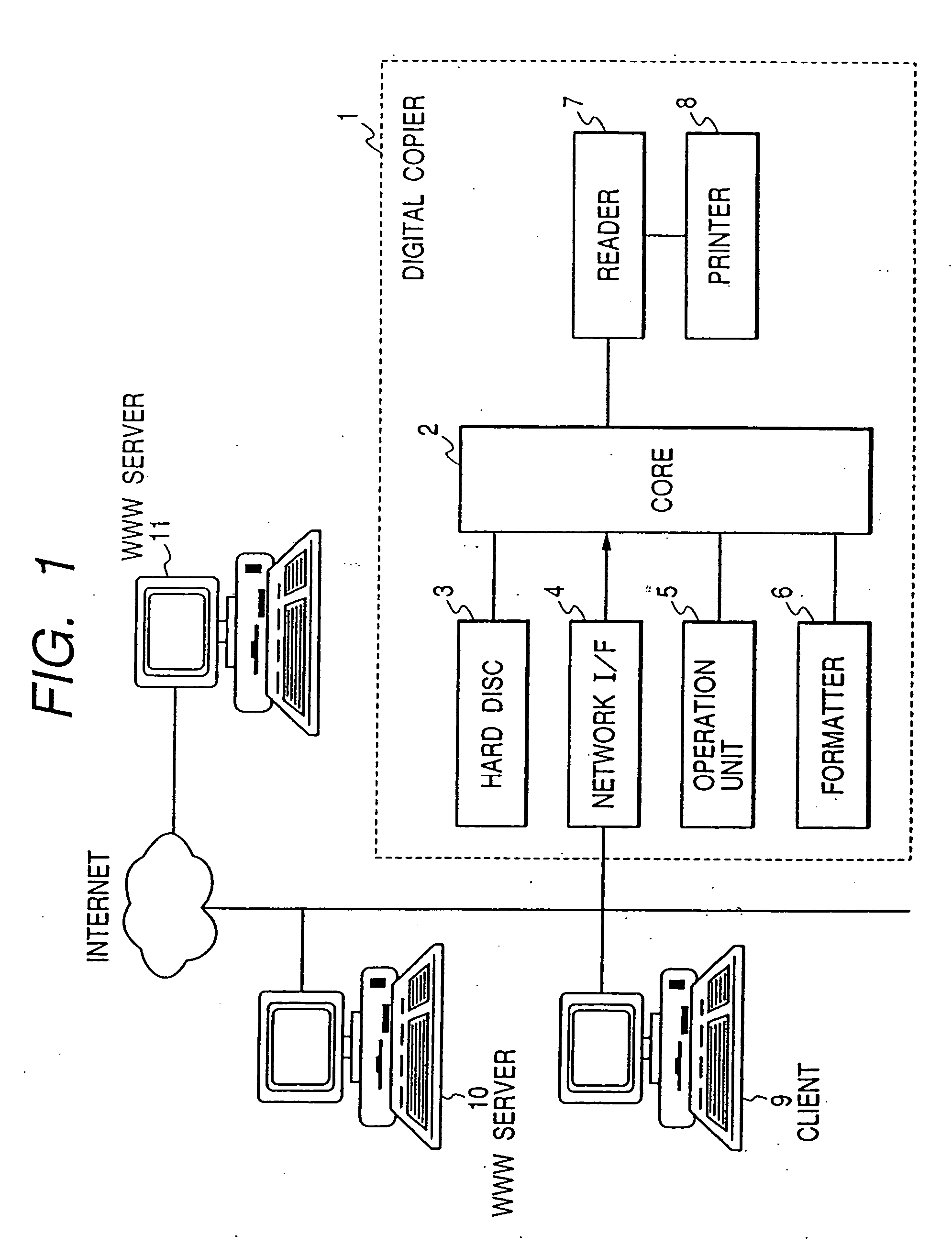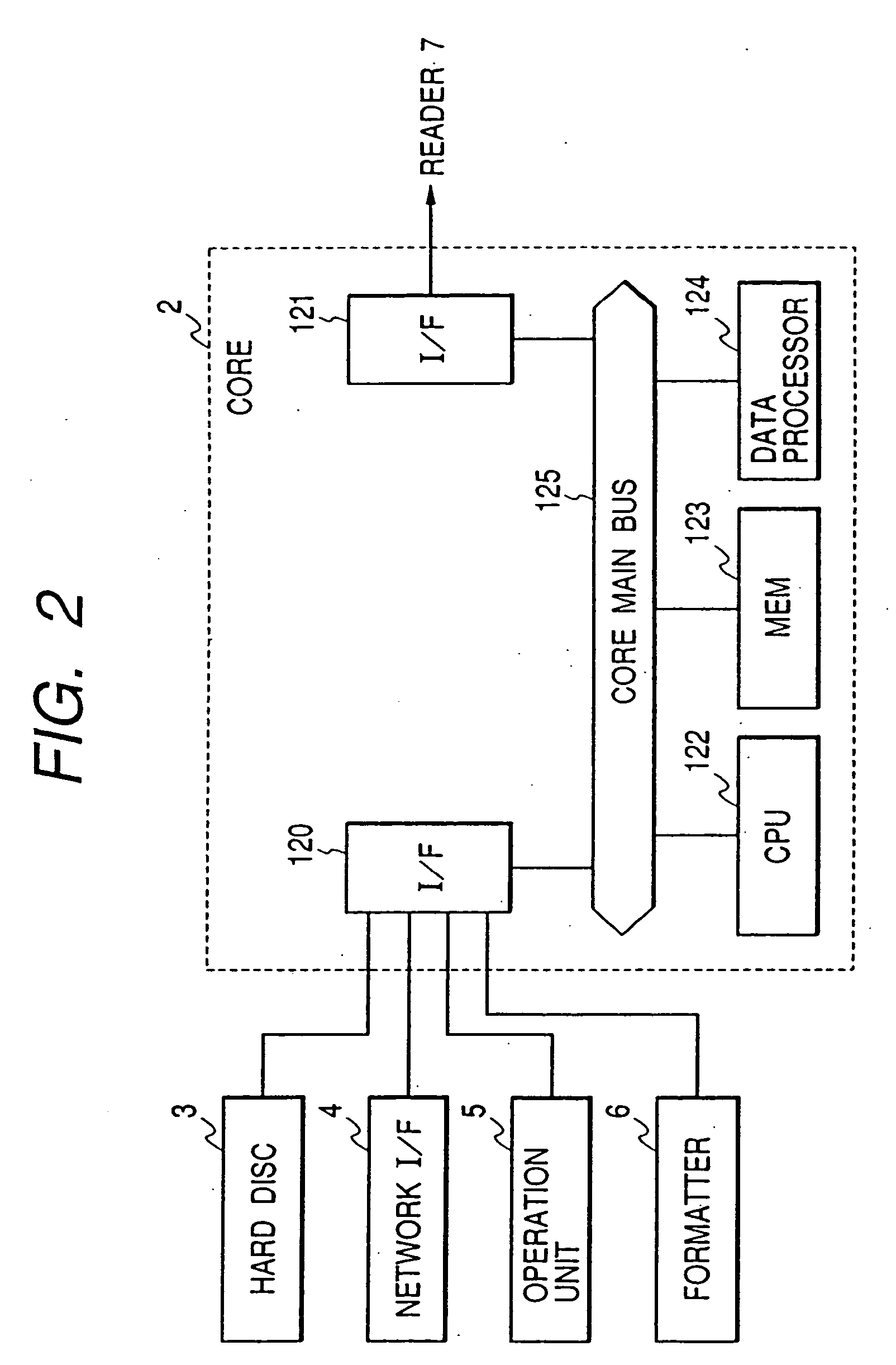Image forming apparatus, image forming method, and storing medium
a technology of image forming and forming methods, applied in the direction of digital output to print units, visual presentations, instruments, etc., can solve the problems of increasing the traffic of the network, the burden of computer processing, and the influence of traffic, so as to reduce the load
- Summary
- Abstract
- Description
- Claims
- Application Information
AI Technical Summary
Benefits of technology
Problems solved by technology
Method used
Image
Examples
first embodiment
[0080]FIG. 1 is a block diagram showing a construction of the first embodiment of an image forming apparatus of the invention. In the embodiment, an image forming apparatus comprising a digital copier will be explained as an example.
[0081] As shown in FIG. 1, a digital copier 1 comprises a reader 7, a printer 8, and a core 2. The reader 7 reads an image of an original and outputs image data according to the original image to the printer 8 and core 2. The printer 8 records the image according to the image data from the reader 7 and core 2 onto a recording paper. The core 2 connects the reader 7 and also connects a hard disc 3, a network interface (hereinafter, referred to as a network I / F) 4, an operation unit 5, and a formatter 6.
[0082] The hard disc 3 stores various control programs, image data, and the like.
[0083] The network I / F 4 has an interface to connect the core 2 to a network. The network comprises an intranet. A client 9 and an intranet WWW server 10 are connected to th...
second embodiment
[0216] The second embodiment of the invention will now be described with reference to FIGS. 17 to 30. FIG. 17 is a block diagram showing a construction of the second embodiment of an image forming apparatus of the invention. The same component elements as those in the foregoing first embodiment are designated by the same reference numerals and their descriptions are omitted.
[0217] As shown in FIG. 17, the image forming apparatus of the embodiment comprises the reader 7, printer 8, and an image input / output controller 1701. The image I / O controller 1701 connects the reader 7 and has a facsimile 1704, a file 1705, a network I / F 1707, a formatter 1708, an image memory 1709, and a core 1710.
[0218] The facsimile 1704 is a circuit for decompressing compressed image data received through a telephone line, transferring the decompressed image data to the core 1710, compressing the image data transferred from the core 1710, and transmitting the compressed image data through the telephone li...
third embodiment
[0284] The third embodiment of the invention will now be described with reference to the constructional diagram of FIG. 3.
[0285] Processes which are peculiar to the embodiment will now be described in accordance with flowcharts of FIGS. 32 to 34.
[0286] First, a registering process of the URL information and access frequency information will be explained in accordance with the flowchart of FIG. 32.
[0287] By detecting a predetermined key operation signal, when the input unit 302 recognizes that a registering mode of the URL information and access frequency information has been set, this fact is notified as a data input request to the user I / F manager 303.
[0288] In response to the data input request from the input unit 302, the user I / F manager 303 displays a message asking the designation of the URL information of hyper text data whose printing is desired to the display 301 (step S3201).
[0289] The user I / F manager 303 accepts the designating operation of the URL information by th...
PUM
 Login to View More
Login to View More Abstract
Description
Claims
Application Information
 Login to View More
Login to View More - R&D
- Intellectual Property
- Life Sciences
- Materials
- Tech Scout
- Unparalleled Data Quality
- Higher Quality Content
- 60% Fewer Hallucinations
Browse by: Latest US Patents, China's latest patents, Technical Efficacy Thesaurus, Application Domain, Technology Topic, Popular Technical Reports.
© 2025 PatSnap. All rights reserved.Legal|Privacy policy|Modern Slavery Act Transparency Statement|Sitemap|About US| Contact US: help@patsnap.com



